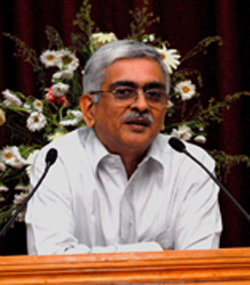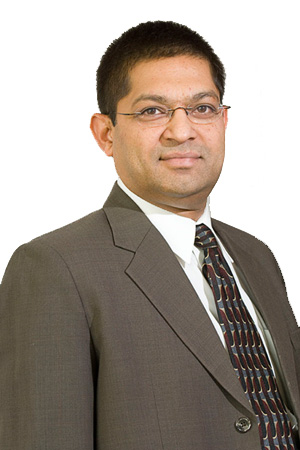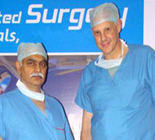As a part of its strategy, Trivitron will collaborate with leading research centers and Institutes in the country, where advanced research is already in progress. The company will work towards developing these laboratory level prototypes into manufacturable technologies. As a first step, Trivitron has already tied up with IIT Madras by setting up a Trivitron Innovation Centre in the Depart of Engineering Design at IITM. Linking with other leading R&D groups in the country like the Biomedical Technology Wing of the Sree Chitra Tirunal Institute for Medical Sciences and Technology, Trivandrum is an important part of the future plans. The other critical part of the innovation strategy is to set up R&D groups within each of its business units with strong collaborations within and outside the company.

Director, Trivitron
1.What motivated you to enter Healthcare sector? In your opinion what are the advantages being in Healthcare sector?
With over 36 years in the field of BIOMEDICAL TECHNOLOGY development at SCTIMST, Trivandrum, covering areas of design (devices and test systems), evaluation, pilot production and technology transfer of critical ARTIFICIAL ORGANS and 2 years as graduate student at I.I.T. Madras in the area of Medical electronics, Dr Bhuvaneshwar has numerous projects to his credit.
I joined Sree Chitra in 1976 and has been associated with the Biomedical Technology Wing right from its inception. I have been involved in the development of a number of implantable and other critical medical devices, which have been successfully commercialized by the Indian industry.
During 2000 – 2003, under my leadership, a quality system conforming to ISO-17025 for biomedical testing services was implemented and accredited by COFRAC of France. This enabled the Biomedical Technology Wing of SCTIMST, Trivandrum to extend its biocompatibility and other testing services to the Indian industry and thereby enabling them to compete globally by obtaining the CE mark or US-FDA approvals.
I received several awards including the Distinguished Alumnus Award (2001) of IIT Madras, shared the FIE foundation award (1995) for the development of Chitra Heart Valve and NRDC-Awards for meritorious invention for Chitra Heart Valve (1994) and Spictra Membrane Oxygenator (2006).
2. Recently you joined Trivitron, would you like to share some insights on the company’s growth and expansion in this sector?
Trivitron is committed to ensuring that its products and services conform to the highest standards of international quality. As a part of this commitment, it is already implementing ISO 9000-2001, ISO 13485, CE, US FDA & Japan MITI certifications in all aspects of its manufacturing, marketing and management. Testing of devices, whether it is as a part of manufacturing and service support or as a part of innovation and development, will be carried out to meet all applicable international standards
3. What makes India such an attractive destination for Healthcare companies?
The availability of low cost Microprocessors, high reliability electronics & wireless communication at ever increasing complexity and lowered prices and their application to the healthcare products has been the most exciting advance in the last 10 years.
4. Which are your most successful implementations large projects globally so far? Enlighten us about “Tilting disc heart valve prosthesis”.
Main research interests have been in the development of cardiovascular devices and blood compatibility of materials. Major contributions are in the development and commercialization of medical devices such as tilting disc heart valve (TTK-CHITRA HEART VALVE — TTK Health Care Ltd, Chennai), Hydrocephalus Shunt System (CEREDRAIN – Hindustan Latex Ltd, Trivandrum), Hollow Fiber Membrane Oxygenator (SPICTRA — SIDD Lifesciences Ltd., Chennai) and a few others.
The Tilting Disc Heart valve continues to be a major benchmark for the Medical Devices development in India. Despite the considerable inflation over the last two decades, it has been possible by TTK Healthcare Ltd., to sell it in the price range of INR 20,000-25,000 since 1995, when it was first introduced into the Indian market.
The result of this is that other competing mechanical heart valves manufactured by MNCs are sold in India in the price range of Rs.20,000 to Rs, 25,000 even today; while their international prices are in range of US$ 2000 to 3000. The benefit of this competition, irrespective of which valve is implanted has gone to the people of India.
Development of implants is most challenging and within this area, development of a blood compatible devices has even greater challenges. On top of these requirements, the need for high wear and fatigue resistance for heart valves, posed the greatest of challenges in identification of suitable materials, design, fabrication and testing of the device.
5. Medical Devices development is an expanding sector, what are the areas focused while designing various medical devices? What is the target market like?
Medical devices and equipment market has grown consistently at over 10 to 15% per annum over the last 2 decades in the country – probably at a much higher rate in the last five years as a result of the growth of the country’s economy and the demand from a expanding middle class. Healthcare is a major focus area of the Government of India in the 12th Five year plan with the aim of making it affordable to all.
So, all put together, there is no doubt that the medical devices industry in the country is poised for a substantial growth in the coming decade.
Accreditation of Medical services for improving and maintaining the standards of healthcare in the country is definitely a necessity. This is the only way hospitals, clinics and test laboratories will provide a minimum quality of service to everyone in the country. At present, one has to pay higher prices for getting better quality service and there is no method of guaranteeing that one will get it just because you are paying more.
6. What are the market opportunities for Indian medical equipment Industry in the next few years i.e. till 2015?
Medical devices and equipment market has grown consistently at over 10 to 15% per annum over the last 2 decades in the country – probably at a much higher rate in the last five years as a result of the growth of the country’s economy and the demand from a expanding middle class. Healthcare is a major focus area of the Government of India in the 12th Five year plan with the aim of making it affordable to all.
So, all put together, there is no doubt that the medical devices industry in the country is poised for a substantial growth in the coming decade.
The 21st Century has been termed the “Century of Biology”. During the nest 10 to 20 years, we are going to witness advances in Molecular biology, microelectronics (including MEMS) and Nano-materials that will combine together to give us new diagnostic tools and treatment modalities. Nano material based point of care diagnostics of many disease conditions which can be done by the doctor in his clinic without having to send a blood sample to a clinical lab. Advances in Robotic and minimally invasive surgery which will make many surgical procedures safer, more effective with minimum pain. Treatments for many conditions particularly in cancer, for which we do not have any effective ones now.
7. Emerging markets like India & other Asian regions are currently witnessing faster maturity among healthcare providers towards adoption of IT driven systems and sophisticated technology applications. How do you foresee opportunities in such markets and what are your strategies to expand business in these markets?
The current market areas of investment and focus at Trivitron are Imaging sciences, Lab Diagnostics, Cardiology and Critical Care & Life Support Solutions. As a part of its new innovation strategy, Trivitron will focus for innovation in these areas and introduce innovative and cost effective products in the coming years.
As a part of its strategy, Trivitron will collaborate with leading research centers and Institutes in the country, where advanced research is already in progress. The company will work towards developing these laboratory level prototypes into manufacturable technologies. As a first step, Trivitron has already tied up with IIT Madras by setting up a Trivitron Innovation Centre in the Depart of Engineering Design at IITM. Linking with other leading R&D groups in the country like the Biomedical Technology Wing of the Sree Chitra Tirunal Institute for Medical Sciences and Technology, Trivandrum is an important part of the future plans. The other critical part of the innovation strategy is to set up R&D groups within each of its business units with strong collaborations within and outside the company.



